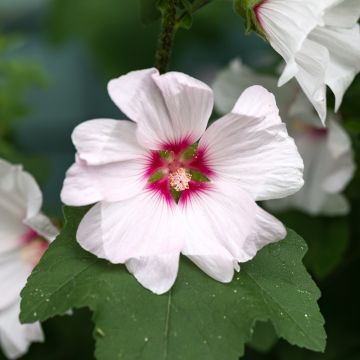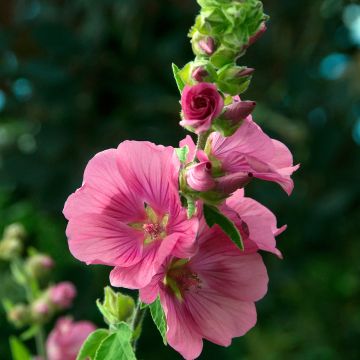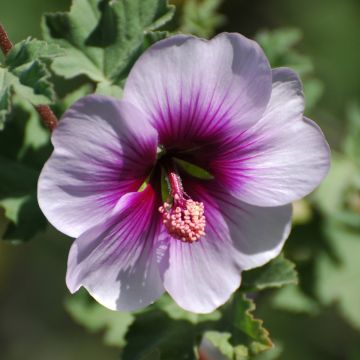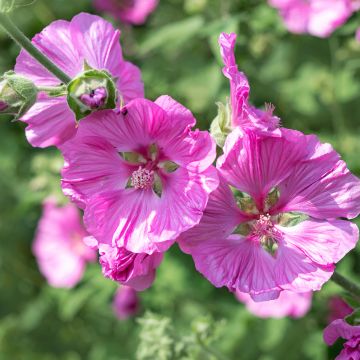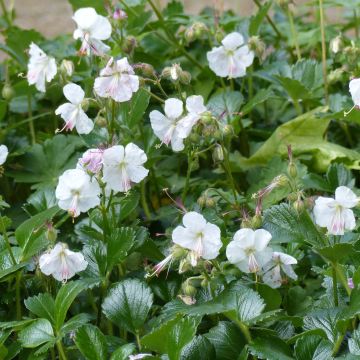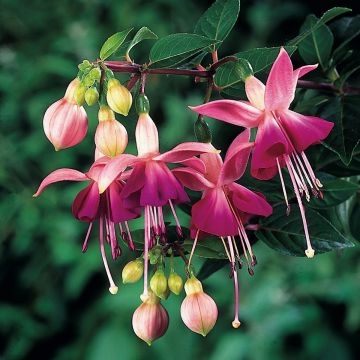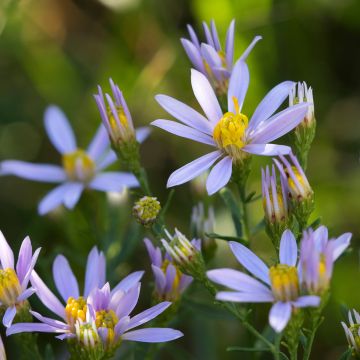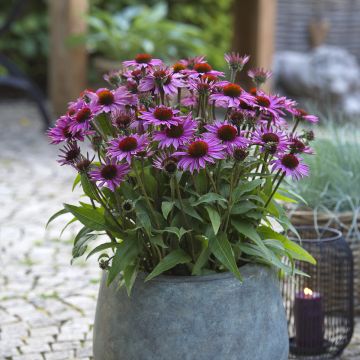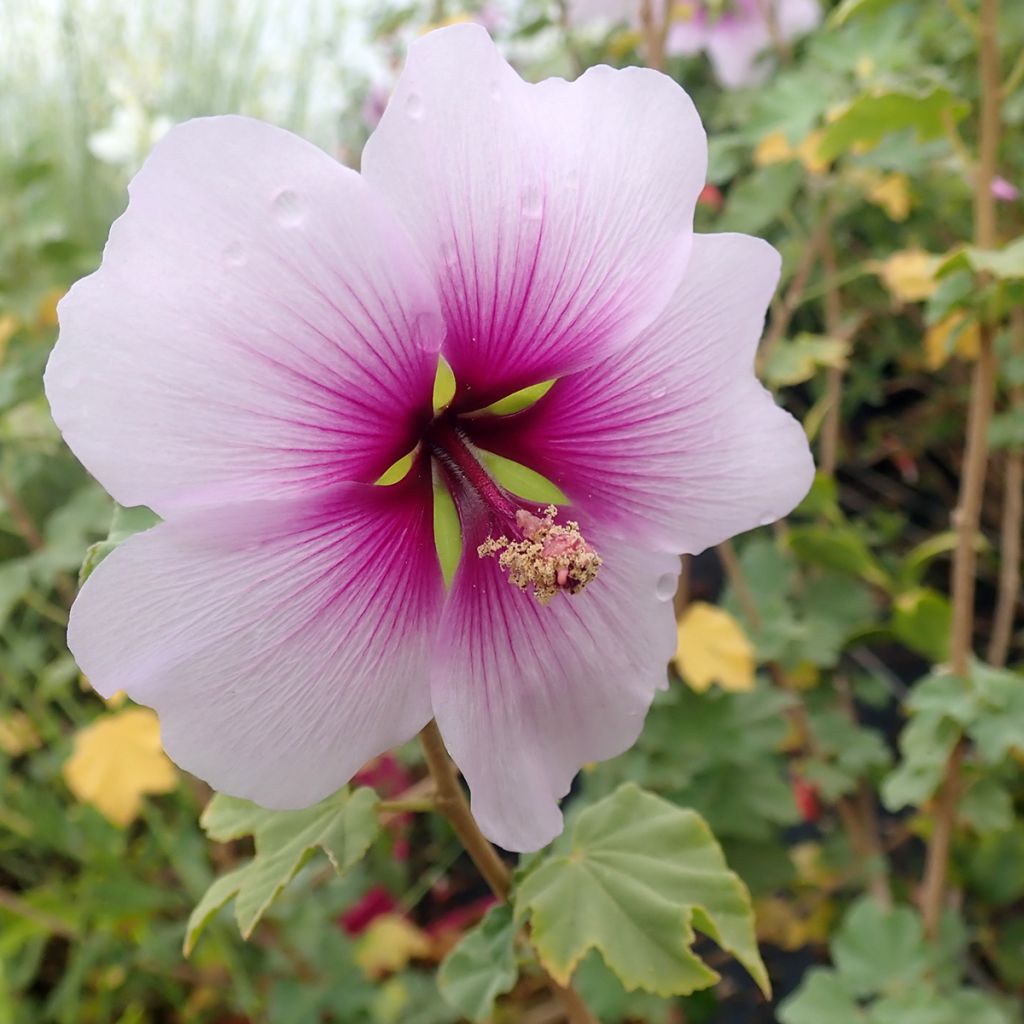

Malva subovata Princesse de Ligne - Mallow
Malva subovata Princesse de Ligne - Mallow
Malva subovata Princesse de Ligne
Mallow
This plant carries a 12 months recovery warranty
More information
We guarantee the quality of our plants for a full growing cycle, and will replace at our expense any plant that fails to recover under normal climatic and planting conditions.
From €5.90 for pickup delivery and €6.90 for home delivery
Express home delivery from €8.90.
Delivery to Corse prohibited: UE law prohibits the import of this plant from mainland France to Corse as part of the fight against Xylella fastidiosa. Please accept our sincere apologies.
More information
Does this plant fit my garden?
Set up your Plantfit profile →
Description
The Lavatera maritima 'Princesse de Ligne', now renamed Malva subovata 'Princesse de Ligne', is a beautiful perennial shrub and bush that blooms all summer long, and even into the early days of autumn. Its delicate flowers, in cups, in two shades of pink, brighten up a beautiful grey and velvety foliage. It is a plant of rapid growth, generous, but short-lived. It will thrive in full sun and in dry, well-drained, light soil. Native to Mediterranean coasts, it is moderately hardy, but very drought-resistant and salt spray-tolerant. A very pretty plant for rockeries and flower beds.
Originally from the south of France, the seaside mallow is also known as Spanish mallow. It is mainly found on the Mediterranean coast, growing in gravel and between rocks, in warm and dry conditions. It is a woody perennial, even a shrub, with rough, grey stems. Hardy down to -7°C (19.4°F), this plant tolerates limestone and salt.
The cultivar 'Princesse de Ligne' looks very much like it, but its flowers are more distinctly coloured. Growing rapidly, it reaches between 60 cm (24in) and 1.5 m (5ft) in height with a spread of 1 m (3ft), depending on growing conditions. The numerous saucer-shaped flowers have five pale pink lilac petals, veined and speckled with fuchsia pink to magenta near the centre. They measure 4 cm (2in) in diameter. In our gardens, they bloom from June to October. In the Mediterranean region, flowering will be earlier. The foliage of this tree mallow is evergreen in winter, thick, and tomentose. The leaves are suborbicular in shape, with a greyish green, pastel colour, just like its flowers.
Combine the seaside mallow 'Princesse de Ligne' with other Mediterranean plants such as rockroses, lavenders, spurges, and teucriums. All these plants for dry terrain and seaside are ideal for landscaping rockeries, well-drained flower beds, and other flower beds with rocky or sandy soil. You can also mix it with other shrubby mallows and arborescent wormwoods 'Powis Castle' in a small flowering hedge.
Report an error about the product description
Flowering
Foliage
Plant habit
Botanical data
Malva
subovata
Princesse de Ligne
Malvaceae
Mallow
Lavatera maritima
Mediterranean
Other Lavatera - Tree Mallow
Planting and care
Plant Wood Mallows in full sun in well-drained, sandy or rocky soil, even limestone. Protect them from cold and drying winds. They resist sea spray well. These flowers can be cut to make bouquets. Pruning stimulates growth and makes the plants stronger. Severely prune the clump in spring to stimulate its growth and promote abundant flowering. Every year, as soon as the buds swell in March, leave only two or three buds at the base of the new shoots, to form a sturdy frame. Remove excess or misplaced old wood. Wood Mallows do not live very long, but they self-seed. Their cold resistance will be better in dry soil in winter.
Planting period
Intended location
Care
This item has not been reviewed yet - be the first to leave a review about it.
Summer flowering perennials
Haven't found what you were looking for?
Hardiness is the lowest winter temperature a plant can endure without suffering serious damage or even dying. However, hardiness is affected by location (a sheltered area, such as a patio), protection (winter cover) and soil type (hardiness is improved by well-drained soil).

Photo Sharing Terms & Conditions
In order to encourage gardeners to interact and share their experiences, Promesse de fleurs offers various media enabling content to be uploaded onto its Site - in particular via the ‘Photo sharing’ module.
The User agrees to refrain from:
- Posting any content that is illegal, prejudicial, insulting, racist, inciteful to hatred, revisionist, contrary to public decency, that infringes on privacy or on the privacy rights of third parties, in particular the publicity rights of persons and goods, intellectual property rights, or the right to privacy.
- Submitting content on behalf of a third party;
- Impersonate the identity of a third party and/or publish any personal information about a third party;
In general, the User undertakes to refrain from any unethical behaviour.
All Content (in particular text, comments, files, images, photos, videos, creative works, etc.), which may be subject to property or intellectual property rights, image or other private rights, shall remain the property of the User, subject to the limited rights granted by the terms of the licence granted by Promesse de fleurs as stated below. Users are at liberty to publish or not to publish such Content on the Site, notably via the ‘Photo Sharing’ facility, and accept that this Content shall be made public and freely accessible, notably on the Internet.
Users further acknowledge, undertake to have ,and guarantee that they hold all necessary rights and permissions to publish such material on the Site, in particular with regard to the legislation in force pertaining to any privacy, property, intellectual property, image, or contractual rights, or rights of any other nature. By publishing such Content on the Site, Users acknowledge accepting full liability as publishers of the Content within the meaning of the law, and grant Promesse de fleurs, free of charge, an inclusive, worldwide licence for the said Content for the entire duration of its publication, including all reproduction, representation, up/downloading, displaying, performing, transmission, and storage rights.
Users also grant permission for their name to be linked to the Content and accept that this link may not always be made available.
By engaging in posting material, Users consent to their Content becoming automatically accessible on the Internet, in particular on other sites and/or blogs and/or web pages of the Promesse de fleurs site, including in particular social pages and the Promesse de fleurs catalogue.
Users may secure the removal of entrusted content free of charge by issuing a simple request via our contact form.
The flowering period indicated on our website applies to countries and regions located in USDA zone 8 (France, the United Kingdom, Ireland, the Netherlands, etc.)
It will vary according to where you live:
- In zones 9 to 10 (Italy, Spain, Greece, etc.), flowering will occur about 2 to 4 weeks earlier.
- In zones 6 to 7 (Germany, Poland, Slovenia, and lower mountainous regions), flowering will be delayed by 2 to 3 weeks.
- In zone 5 (Central Europe, Scandinavia), blooming will be delayed by 3 to 5 weeks.
In temperate climates, pruning of spring-flowering shrubs (forsythia, spireas, etc.) should be done just after flowering.
Pruning of summer-flowering shrubs (Indian Lilac, Perovskia, etc.) can be done in winter or spring.
In cold regions as well as with frost-sensitive plants, avoid pruning too early when severe frosts may still occur.
The planting period indicated on our website applies to countries and regions located in USDA zone 8 (France, United Kingdom, Ireland, Netherlands).
It will vary according to where you live:
- In Mediterranean zones (Marseille, Madrid, Milan, etc.), autumn and winter are the best planting periods.
- In continental zones (Strasbourg, Munich, Vienna, etc.), delay planting by 2 to 3 weeks in spring and bring it forward by 2 to 4 weeks in autumn.
- In mountainous regions (the Alps, Pyrenees, Carpathians, etc.), it is best to plant in late spring (May-June) or late summer (August-September).
The harvesting period indicated on our website applies to countries and regions in USDA zone 8 (France, England, Ireland, the Netherlands).
In colder areas (Scandinavia, Poland, Austria...) fruit and vegetable harvests are likely to be delayed by 3-4 weeks.
In warmer areas (Italy, Spain, Greece, etc.), harvesting will probably take place earlier, depending on weather conditions.
The sowing periods indicated on our website apply to countries and regions within USDA Zone 8 (France, UK, Ireland, Netherlands).
In colder areas (Scandinavia, Poland, Austria...), delay any outdoor sowing by 3-4 weeks, or sow under glass.
In warmer climes (Italy, Spain, Greece, etc.), bring outdoor sowing forward by a few weeks.


































